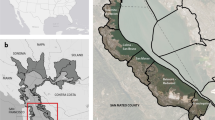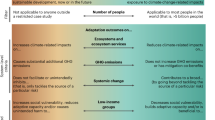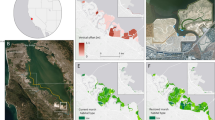Abstract
Adapting to climate change is among the biggest challenges humanity faces in the next century. An overwhelming focus of adaptation strategies to reduce climate change-related hazards has been on hard-engineering structures such as sea walls, irrigation infrastructure and dams. Closer attention to a broader spectrum of adaptation options is urgently needed. In particular, ecosystem-based adaptation approaches provide flexible, cost-effective and broadly applicable alternatives for buffering the impacts of climate change, while overcoming many drawbacks of hard infrastructure. As such, they are a critical tool at adaptation planners' disposal for tackling the threats that climate change poses to peoples' lives and livelihoods.
This is a preview of subscription content, access via your institution
Access options
Subscribe to this journal
Receive 12 print issues and online access
$209.00 per year
only $17.42 per issue
Buy this article
- Purchase on Springer Link
- Instant access to full article PDF
Prices may be subject to local taxes which are calculated during checkout

Similar content being viewed by others
References
Kiehl, J. Lessons from Earth's past. Science 331, 158–159 (2011).
Good, P. et al. An Updated Review of Developments in Climate Science Research since the IPCC Fourth Assessment Report (Met Office Hadley Center, Walker Institute, Tyndall Centre, 2010). This report details the state of current climate science research and updates IPCC research.
IPCC Climate Change 2007: Impacts, Adaptation and Vulnerability (eds Parry, M., Canziani, O., Palutikof, J., van der Linden, P. & Hanson, C.) (Cambridge Univ. Press, 2007).
United Nations Framework Convention on Climate Change Investment and Financial Flows to Address Climate Change (UNFCCC, 2007).
Parry, M. et al. Assessing the Costs of Adaptation to Climate Change: A Review of the UNFCCC and Other Recent Estimates (International Institute for Environment and Development and Grantham Institute for Climate Change, 2009).
Hallegatte, S. Strategies to adapt to an uncertain climate change. Glob. Environ. Change 19, 240–247 (2009).
World Bank Economics of Adaptation to Climate Change: Synthesis Report (World Bank, 2010). An extensive report on the costs of climate change adaptation structures to meet the adaptation needs of the planet.
Hale, L. C., Newkirk, S. & Beck, M. Helping coastal communities adapt to climate change. Solutions 2, 84–85 (2011).
Alongi, D. M. Mangrove forests: Resilience, protection from tsunamis, and responses to global climate change. Estuar. Coast. Shelf Sci. 76, 1–13 (2008). A review of mangrove ecosystems' roles in coastal protection, their response to climate change stressors and their prospects in a future of climate change.
Shepard, C. C., Crain, C. M. & Beck, M. W. The protective role of coastal marshes: A systematic review and meta-analysis. PLoS ONE 6, e27374 (2011). A review and meta-analysis of the protective role of salt marshes.
Das, S. & Vincent, J. R. Mangroves protected villages and reduced death toll during Indian super cyclone. Proc. Natl Acad. Sci. USA 106, 7357–7360 (2009).
Emanuel, K. Increasing destructiveness of tropical cyclones over the past 30 years. Nature 436, 686–688 (2005).
Schuyt, K. Freshwater and Poverty Reduction: Saving People, Saving Nature (Worldwide Fund for Nature, 2005).
Yu, X. et al. Freshwater management and climate change adaptation: Experiences from the central Yangtze in China. Clim. Dev. 1, 241–248 (2009).
Moberg, F. & Rönnbäck, P. Ecosystem services of the tropical seascape: Interactions, substitutions and restoration. Ocean Coast. Manage. 46, 27–46 (2003).
IPCC Climate Change 2007: The Physical Science Basis (eds Solomon, S. et al.) (Cambridge Univ. Press, 2007).
Emerton, L., Baig, S. & Saleem, M. Valuing Biodiversity: The Economic Case for Biodiversity Conservation in the Maldives (AEC Project, Ministry of Housing, Transport and Environment, Government of Maldives and UNDP Maldives, 2009).
Mohamed, M. Economic Valuation of Coral Reefs: A Case Study of the Costs and Benefits of Improved Management of Dhigali Haa, a Marine Protected Area in Baa Atoll, Maldives MESc thesis, Univ. Canterbury (2007).
Colls, A., Ash, N. & Ikkala, N. Ecosystem-based Adaptation: A Natural Response to Climate Change (IUCN, 2009).
Hoegh-Guldberg, O. et al. Coral reefs under rapid climate change and ocean acidification. Science 318, 1737–1742 (2007).
Hughes, T. P. et al. Climate change, human impacts, and the resilience of coral reefs. Science 301, 929–933 (2003). A review of the goods and services coral reefs provide to humanity and the threats they face from climate change, with a discussion of management strategies to boost reef resilience.
World Bank Convenient Solutions to an Inconvenient Truth: Ecosystem-based Approaches to Climate Change (World Bank, 2009).
Tri, N. H., Adger, W. N. & Kelly, P. M. Natural resource management in mitigating climate impacts: The example of mangrove restoration in Vietnam. Glob. Environ. Change 8, 49–61 (1998).
Dubgaard, A. Cost-benefit analysis of wetland restoration. J. Water Land Dev. 8, 87–102 (2004).
United Nations The Millennium Development Goals Report (UN, 2011).
Game, E. T. et al. Dynamic marine protected areas can improve the resilience of coral reef systems. Ecol. Lett. 12, 1336–1346 (2009).
Mumby, P. J., Hastings, A. & Edwards, H. J. Thresholds and the resilience of Caribbean coral reefs. Nature 450, 98–101 (2007).
Scheffer, M. et al. Catastrophic shifts in ecosystems. Nature 413, 591–596 (2001).
Beisner, B. E., Haydon, D. T. & Cuddington, K. Alternative stable states in ecology. Front. Ecol. Environ. 1, 376–383 (2003).
Milly, P. C. D. et al. Stationarity is dead: Whither water management? Science 319, 573–574 (2008).
Matthews, J. H. & Wickel, A. J. Embracing uncertainty in freshwater climate change adaptation: A natural history approach. Clim. Dev. 1, 269–279 (2009).
Turner, W. R. et al. Climate change: Helping nature survive the human response. Conserv. Lett. 3, 304–312 (2010).
Batker, D. et al. Gaining ground: The value of restoring the Mississippi River Delta (Earth Economics, 2010).
Day, J. W. Jr et al. Restoration of the Mississippi Delta: Lessons from hurricanes Katrina and Rita. Science 315, 1679–1684 (2007).
Watts, R. J., Richter, B. D., Opperman, J. J. & Bowmer, K. H. Dam reoperation in an era of climate change. Mar. Freshwat. Res. 62, 321–327 (2011).
International Federation of Red Cross and Red Crescent Societies Breaking the Waves: Impact Analysis of Coastal Afforestation for Disaster Risk Reduction in Viet Nam (International Federation of Red Cross and Red Crescent Societies, 2011).
Hillen, M. M. Safety Standards Project, Risk Analysis for New Sea Dike Design Guidelines in Vietnam (Delft Univ. Technology/Hanoi Water Resources Univ., 2008).
Mutter, J. Disasters widen the rich–poor gap. Nature 466, 1042 (2010). Details the disproportionate impacts of disasters such as hurricanes on low-income people.
Sachs, J. D. et al. Biodiversity conservation and the Millennium Development Goals. Science 325, 1502–1503 (2009).
United Nations Development Programme Evaluation of UNDP Contribution to Environmental Management for Poverty Reduction: The Poverty–Environment Nexus (UNDP, 2010).
Pramova, E., Locatelli. B., Brockhaus. M. & Fohlmeister. S. Ecosystem services in the national adaptation programmes of action. Clim. Policy http://dx.doi.org/10.1080/14693062.2011.647848 (in the press).
Ebert, S., Hulea, O. & Strobel, D. Floodplain restoration along the lower Danube: A climate change adaptation case study. Clim. Dev. 1, 212–219 (2009).
Feagin, R. A. et al. Shelter from the storm? Use and misuse of coastal vegetation bioshields for managing natural disasters. Conserv. Lett. 3, 1–11 (2010).
Cahoon, D. R. et al. in Wetlands and Natural Resource Management (eds Caldwell, M. M. et al.) 271–292 (Springer Berlin Heidelberg, 2006).
Kirwan, M. & Temmerman, S. Coastal marsh response to historical and future sea-level acceleration. Quat. Sci. Rev. 28, 1801–1808 (2009).
Butchart, S. H. M. et al. Global biodiversity: Indicators of recent declines. Science 328, 1164–1168 (2010).
Hobbs, R. J., Higgs, E. & Harris, J. A. Novel ecosystems: Implications for conservation and restoration. Trends Ecol. Evol. 24, 599–605 (2009).
The Economics of Ecosystems and Biodiversity Mainstreaming the Economics of Nature: A Synthesis of the Approach, Conclusions and Recommendations of TEEB (Progress Press, 2010).
Wegner, G. & Pascual, U. Cost–benefit analysis in the context of ecosystem services for human well-being: A multidisciplinary critique. Glob. Environ. Change 21, 492–504 (2011).
Conservation International Economic Values of Coral Reefs, Mangroves, and Seagrasses: A Global Compilation (Conservation International, 2008).
Hendry, M. in Climate Change in the Intra-Americas Sea (ed. Maul, G. A.) 152–161 (UNEP, 1993).
Batker, D. K. Supplemental Ecological Services Study: Tolt River Watershed Asset Management Plan (Earth Economics, 2005).
Schmidt, C. W. Keeping afloat — A strategy for small island nations. Environ. Health Persp. 113, 606–609 (2005).
Hillen, M. M. et al. Coastal Defence Cost Estimates: Case Study of the Netherlands, New Orleans and Vietnam (Delft Univ. Technology, Royal Haskoning, Univ. Southampton, 2010).
Postel, S. L. & Thompson, B. H. Watershed protection: Capturing the benefits of nature's water supply services. Nat. Resour. Forum 29, 98–108 (2005).
Carrascal, D. R. Signals of Climate Variability/Change in Surface Water Supply of High-Mountain Watersheds. Case study: Claro River High Mountain Basin, Los Nevados Natural Park, Andean Central Mountain Range Ch. 5 (Escuela de Ingeniería de Antioquia, 2009).
Medalla, E. Bucaramanga reservoir to cost US$127mn in 2 stages — Colombia. Business News Americas (12 November 2009).
Scherr, S. J. & Sthapit, S. Sustainable Land Management in Africa: Opportunities for Climate Change Adaptation (TerrAfrica, 2009).
Tengo, M. & Belfrage, K. Local management practices for dealing with change and uncertainty: A cross-scale comparison of cases in Sweden and Tanzania. Ecol. Soc. 9, 4 (2004).
Vecino, J. B., Gomez-Barbero, M. & Baldovin, M. J. L. (eds) Survey of Current Institutional Framework for Water Management in European Irrigated Systems (Univ. Cordoba, 2002).
Singh, A. et al. Small holders' irrigation — Problems and options. Wat. Resour. Manage. 23, 289–302 (2009).
Acknowledgements
We thank B. Nickel for GIS support and the Zavaleta lab, and R. Naylor for comments that improved this manuscript.
Author information
Authors and Affiliations
Corresponding authors
Rights and permissions
About this article
Cite this article
Jones, H., Hole, D. & Zavaleta, E. Harnessing nature to help people adapt to climate change. Nature Clim Change 2, 504–509 (2012). https://doi.org/10.1038/nclimate1463
Published:
Issue Date:
DOI: https://doi.org/10.1038/nclimate1463
This article is cited by
-
How Do Structural Safety, Ecological Functions and Social Development Influence Construction of Ecological Seawalls for Coastal Protection and Sustainability?
Water Resources Management (2024)
-
MEIC-global-CO2: A new global CO2 emission inventory with highly-resolved source category and sub-country information
Science China Earth Sciences (2024)
-
Evidence-based target setting informs blue carbon strategies for nationally determined contributions
Nature Ecology & Evolution (2023)
-
Nature-based solutions for climate change adaptation are not located where they are most needed across the Alps
Regional Environmental Change (2023)
-
Exploring vulnerabilities of inland fisheries in Indian context with special reference to climate change and their mitigation and adaptation: a review
International Journal of Biometeorology (2023)



